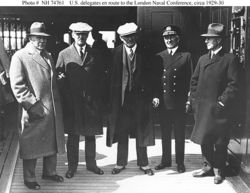What was the 1930 London Naval Conference and was it so important
The London Naval Conference of 1930 was the third in a series of five meetings, formed with the purpose of placing limits on the naval capacity of the world’s largest naval powers. The purpose of the meetings was to promote disarmament in the wake of the devastation of the First World War; they began with the Washington Conference of 1921–22 and concluded with the London Conference of 1935. After an unsuccessful meeting in Geneva in 1927, Great Britain, the United States, Japan, France, and Italy gathered in London in 1930 to make a new attempt at revising and extending the terms of the Five Power Treaty of 1922.
In 1927, Great Britain and the United States could not agree on naval cruiser limits; however, representatives of the two governments continued to work on a compromise measure. By 1930 both sides were anxious to reach a deal to avoid an all-out arms race and, importantly, forced their naval officers to take a back seat to their diplomats in the negotiations.
The restrictions on the tonnage on Great Britain, the United States, and Japan relative to one another were an important issue for discussion. The Washington conference established a ratio of 5:5:3 for capital ships—for every five capital ships the Americans and British had, the Japanese were allowed to have three. As in 1927, Japan insisted that the ratio for auxiliary vessels be increased to 10:10:7, rather than maintaining the 5:5:3 ratio. If the United States was to have 18 heavy cruisers, the latter ratio placed the Japanese limit at 10 cruisers; however, at the time of the conference, Japan had built or was building 12 new ships. The United States was the power most opposed to granting the higher ratio, although it ultimately conceded the point; the official terms of the treaty granted the 10:7 ratio on light cruisers and destroyers and maintained the 10:6 ratio on heavy cruisers, but with a compromise under which the United States delayed its shipbuilding program to give Japan a grace period with a 10:7 ratio in heavy cruisers as well.
What should the maximum tonnage be for light cruisers
The other key issue of the 1930 conference was the maximum tonnage for light cruisers. The United States was adamantly opposed to any maximum lower than 10,000 tons, because given the nature of its international commitments—in particular, its involvement in the Philippines and East Asia and the limited number of refueling stations available in the Pacific—lighter cruisers would not be of much use. Although it compromised on the Japanese ratio and the heavy cruisers, the United States refused to yield on this issue, in spite of the fact that the other powers were far more willing to accept the British maximum of 7,000 tons. In the end, the U.S. position prevailed.
The final treaty limited tonnage of auxiliary ships, as well as the size and gun power of submarines and destroyers. In all but “offensive” ship categories, it granted the Japanese their long-sought 10:10:7 ratio. The treaty also set maximum tonnage for cruisers at 339,000 tons for Great Britain, 323,500 tons for the United States, and 208,850 tons for Japan. The maximum numbers of heavy cruisers were set at 18 for America, 15 for Great Britain, and 12 for Japan. The Treaty upheld and extended the provision in the 1922 treaty that prohibited the powers from building new capital ships for 5 years. The provisions in both the Five-Power Treaty of 1922 and the 1930 treaty were set to expire in 1936.
Although it was described as an “arms limitation conference,” in actuality, the London Naval Treaty set limits above the current capacity of some of the powers involved. The U.S. Senate approved the treaty in July of 1930 over the objections of key naval officers concerned that the naval limitations would inhibit the American ability to defend its control of the Philippine islands. Then the United States actually embarked on a shipbuilding program to make up the difference between its existing cruiser tonnage and what it was allotted under the treaty. That building ultimately helped to alleviate some unemployment caused by the Great Depression.
Conclusion
In 1935, the powers met for a second London Naval Conference to renegotiate the Washington and London treaties before their expiration the following year. The Japanese walked out of that conference, but Great Britain, France, and the United States signed an agreement declaring a six-year holiday on building large light cruisers in the 8,000 to 10,000 ton range. That final decision marked the end to the decade-long controversy over cruisers.
- Republished from Office of the Historian, United States Department of State
- Article: The London Naval Conference, 1930
